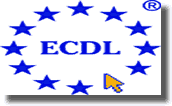 |
ECDL (European
Computer Driving License)
ECDL is a new
European-wide qualification, which enables individuals to demonstrate
their competence in computer skills. Its aims are: to raise the
general level of competency in IT; to improve productivity at work;
to enable employers to invest more efficiently in IT; and to ensure
that best practice and quality issues are understood and implemented.
|
Module
1
Module 2
Module 3
Module 4
Module 5
Module 6
Module 7
|
|

The ECDL syllabus
is designed to cover the key concepts of computing, its practical
applications and their use in the workplace and society in general.
The ECDL takes you through seven modules designed to assess competence
in specific IT areas. Each of the seven computer related modules
is recorded in a distinctive logbook. There will be a 45 minute
assessment upon at the end of each module and on successful completion
of the modules, the European Computer Driving License is awarded.
What
are the benefits?
...For
the individual?
ECDL is designed to help you at work and at home. It will confirm
to potential employers that you have a professionally recognised,
relevant and up-to-date qualification and it will assist in raising
familiarity with the latest technology and its uses.
...For
the employer?
ECDL helps provide proof of competency in the computer skills of
potential employees. Similarly, you could be looking to train up
your workforce and will no doubt want to ensure that the money you
spend on courses is going to be well spent.
«Top»
Module One
Basic Concepts of IT
- Applications
and use of computers
- IT and Society
- Security,
copyright and the law
- Hardware
and systems, software and ergonomics
- Information
Networks
«Top»
Module
Two
Using a computer and managing files
- Create a
directory and a sub-directory - understand the directory structure
- Move and
copy files
- Delete files
from one or more directories
- Examine a
directory, understand the number of files in that directory, the
size of files and the date files were created/updated
- Be able to
print from an installed printer
«Top»
Module
Three
Word Processing
- Using the
functions available in a standard word processing system, move
and copy text within a document, replace words with other words
- Change the
appearance of the text
- Create a
header and footer, use pagination
- Indent text
- Merge mailing
lists with a document
- Import tables
and graphics
- Make a table
within a document
- Use integrated
software
«Top»
Module
Four
Spreadsheets
- Create a
spreadsheet and enter data; Numbers, Text, Formulae
- Format cells
- e.g. size, decimal points, currency, etc
- Use the basic
functions of a spreadsheet, such as Totalling and Averaging
- Understand
and use absolute and relative cell referencing in formulae
- Produce different
types of charts and graphs from spreadsheet figures to analyse
data
- Move information
between spreadsheets
- Work with
more than one spreadsheet
«Top»
Module
Five
Databases / Filing Systems
- Design a
simple database
- Load or log
into an existing database. Enter data into the database. Editing
data and adding records
- Search, select
and sort data, based on criteria given
- Present selected
data in a particular sequence on screen and in reports
- Modifying
the database structure
«Top»
Module
Six
Presentations and drawing
- Creating
a presentation
- Bullet points
to highlight comments
- Clip Art
to insert drawings or symbols
- Organisation
charts
- Use of Slide
shows
«Top»
Module
Seven
Information Network Services
- Use of Electronic
Mail to send a message, file the mail to copy it or forward received
mail
- Connect to
the Internet, retrieving information
Critical Skills (UK) LTD
Tapton Park Innovation Centre
Brimington Road
Chesterfield
Derbyshire
S41 0TZ
Tel : +44 (0) 1246 557 873
Fax : +44 (0) 1246 230 055
information@critical-skills.co.uk
|


